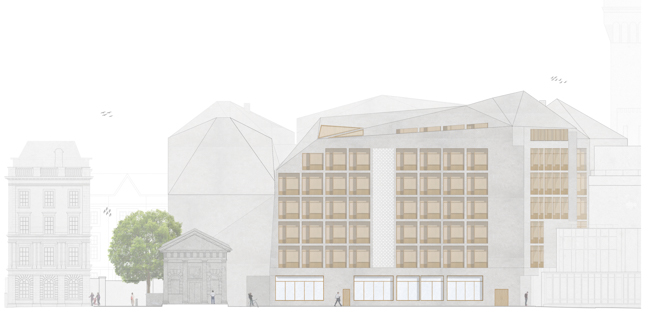Last Friday, An Bord Pleanála, Ireland’s planning board, rejected Trinity’s proposed €52 million redevelopment of Oisín House into a 280-bedroom student accommodation complex. In responding to the decision, Trinity said it would “review” the decision and “consider what is feasible”.
Since then, Trinity College Dublin Students’ Union (TCDSU) have launched a petition calling on the board to reverse its decision amid an ongoing student accommodation crisis, with an unmet demand of around 25,000 student bed spaces nationally, according to the Higher Education Authority (HEA). While Trinity have still not made public their response, there are are a number of options the College can pursue.
Appeal to High Court
While the decision of An Bord Pleanála is final, Trinity can take an appeal to the High Court by making an application for judicial review. Put simply, judicial review is concerned with the decision-making process, not the actual decision — the court would be questioning how the board came to their decision, and not the merits of Trinity’s planning application.
While Trinity could possibly be successful in having the decision declared void, it is generally quite difficult to upset the decisions of An Bord Pleanála through judicial review.
Recent trends in planning litigation have often seen the courts side with the board, who they generally regard as having greater specialist expertise, especially in technical areas such as planning. Speaking to The University Times, professor of environmental law in Trinity, Dr Yvonne Scannell, emphasised the low success rate in judicial review, where it is “ultimately…a matter of judgment of An Bord Pleanála, and on the whole it would be very hard to win a judicial review”.
Scannell, a former board member of Forbas Forbatha (the National Institute for Physical Planning and Development) and Environmental and Planning Consultant for law firm Arthur Cox, said that in order to have the decision overturned “you’d have to show that the decision was so mad that no normal decision-maker would have made the decision like that, or that they failed to take into account something they should have taken into account”.
According to Scannell, the question the courts must ultimately answer is: “Did the board really give a good reason for distinguishing itself from the inspector?”
College might also argue that the board failed to account for context of the decision – namely the ongoing student accommodation crisis. If this argument succeeds, then the decision of the board could be set aside.
It is, however, unlikely that the board was unaware of the ongoing crisis. The need for an expansion of student housing features heavily, for instance, in Dublin City Council’s 2011-2017 city development plan. As such, Scannell noted that the lack of student housing could arguably have been an “overriding consideration” that the board should have accounted for when making their decision.
Nevertheless, she stressed that it would still be “very, very difficult” to upset a decision of An Bord Pleanála, especially given the tendency of the courts to prefer the board’s original decision in similar cases.
Even if the decision is unlikely to go Trinity’s way, we may still see College pursue this option, if only because the alternative is to accept a redesign. Considering the board ignored their inspector’s recommendation to remove a single floor from the project when rejecting the proposal outright, it also seems a more significant redesign would be required to secure the board’s permission.
Redesign
If Trinity decides to avoid a legal process that may prove both unsuccessful and costly, they may opt for a redesign of the proposed redevelopment. This would mean going back to the drawing board and coming up with a new design that An Bord Pleanála might accept.
This might prove easier said than done. Giving their reasons for rejecting Trinity’s application, the board argued that the development would “seriously detract from the visual amenities of the area” and would set a “negative precedent” for future development, as well as having a “negative impact” on the architectural character of the area.
Even a dramatic reduction in height, through the removal of one or two floors, might not addresses these reservations enough for the board to change its mind.

All of this would mean a radical redesign would be necessary. The signature wave-like roof, for instance, might be removed, and it seems inevitable that any redesign will mean the loss of at least 45 student beds.
The application process might soon, however, become easier for Trinity to navigate. Once the Dáil returns from its summer recess, the government plans, as part of its action plan on housing and homelessness, to introduce legislation to create a new fast-track application process for student accommodation.
This would mean Trinity’s new design proposal could bypass Dublin City Council, and go straight to An Bord Pleanála. While this will mean a more efficient application system in the long-run, there is still no real legislative timeline for College to rely on and no real assurance that the bill would definitely pass. At this stage then, such proposed reforms are currently of little help to Trinity.
Refurbish the existing Oisín House
This is probably the least likely option that Trinity will take, especially after spending large amounts of time and money trying to design a redeveloped site.
It is an option the original architect of Oisín House supports, describing it as a “building worth saving”. Brian Hogan, who designed the building in 1973, described the current building in his submission to the inspector’s report as “structurally sound”, saying it could “last indefinitely and be used for a variety of uses such as student accommodation”.
The current building, which was of course formerly used by the Department of Social Protection, covers an area 6,396 square-metres and would be in need of serious refurbishment and redevelopment if it were to be used as student accommodation.
It would also throw into doubt all the new and improved facilities planned as part of the proposed redevelopment. Would there be room for a new college Health Centre, or the planned squash courts and handball alley? How many beds would be lost if College decided to push ahead with the retail units included in the original redevelopment?
Even if proved feasible, such a refurbishment would raise a whole host of questions about which elements of the original redesign could then be incorporated into the existing building.
In his submission, Hogan suggested that Dublin City Council should ensure that Trinity “demonstrates” that it has studied and considered adapting, rather than demolishing, the existing building.
For their part, Trinity were less than enthused about the idea of simply using the existing model. College, in a response provided by planning consultancy firm GVA Planning, told the board that the option of refurbishing the existing Oisin House was “considered”, but found that “the building is not capable of accommodating modern student accommodation”.







